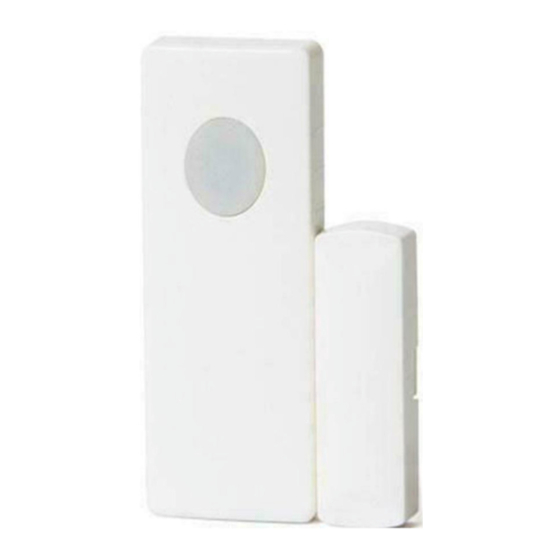
Table of Contents
Advertisement
Quick Links
WST-212 Wireless Contact with Local Bypass
Specifications
Frequency: 345MHz
Battery: 3V lithium CR2032
Battery life: 5-8 years
th
Magnet gap: 5/8
inch max
Enrolling
To enroll the sensor, set your panel into program mode, refer to your specific alarm panel manual
for details on these menus. When prompted by the panel, trigger the sensor by moving the
magnet in and out of range of the sensor. The panel will beep when you have successfully learned
in a sensor.
Bypass Enable/Disable
By default the bypass switch is disabled. To enable this feature, press and hold the bypass button
while installing the battery. The LED will flash twice to indicate bypass is enabled. To disable the
bypass, press and hold the button while installing the battery, the LED will flash once.
Bypass Operation
To bypass the sensor, the door or window being protected must be in the closed position. Press
and hold the bypass button until the LED starts to flash, then open the door or window. The LED
will flash once every 10 seconds to indicate that the sensor is in bypass mode. To remove the
bypass and restore normal operation, simply close the door or window.
Mounting
Included with the contact is double sided tape for the contact and the magnet. For reliable
bonding ensure the surface is clean and dry. Apply the tape to the sensor and then to the desired
location. Apply firm pressure for several seconds. It is not recommended to mount the tape at
temperatures below 50°F, although after 24 hours the bond will hold at low temperatures.
One side of the sensor is marked with 3 lines; this indicates the location of the reed switch. The
magnet should be mounted facing this side of the sensor, and it must be no further than 5/8 of an
inch from the sensor.
Interchangeable covers
The contact comes from the factory assembled with a white cover, but included are optional
brown covers. To change the cover, slide the front cover to disengage it from the sensor then
remove. Replace with the brown cover ensuring the Top (as marked on the inside of the cover)
points away from the battery. You should hear a click when the cover engages and disengages
from the sensor. You do not need to replace the back plastic because once mounted the back is
not visible. To replace the magnet cover you will need to gently pry the white cover off with a flat
head screw driver and snap the brown cover in place.
Replacing the Battery
When the battery is low a signal will be sent to the control panel. To replace the battery:
1.
Slide the top cover to disengage it from the sensor, then remove it to reveal the battery.
2.
Replace with a CR2032 battery ensuring the + side of the battery faces towards you.
3.
Re-attached the cover, ensure the Top (as marked on the inside of the cover) points away
from the battery. You should hear a click when the cover engages properly.
Note: Removing the cover will trigger a zone tamper signal to the control panel
Operating Temperature: 32°-120°F (0°-49°C)
Operating Humidity: 5-95% RH non condensing
Compatible with Honeywell receivers
Supervisory signal interval: 60 min(approx.)
Advertisement
Table of Contents

Summary of Contents for Ecolink WST-212
- Page 1 WST-212 Wireless Contact with Local Bypass Specifications Frequency: 345MHz Operating Temperature: 32°-120°F (0°-49°C) Battery: 3V lithium CR2032 Operating Humidity: 5-95% RH non condensing Battery life: 5-8 years Compatible with Honeywell receivers Magnet gap: 5/8 inch max Supervisory signal interval: 60 min(approx.)
- Page 2 IC: 9863B-WST212 Warranty Ecolink Intelligent Technology Inc. warrants that for a period of 5 years from the date of purchase that this product is free from defects in material and workmanship. This warranty does not apply to damage caused by shipping or handling, or damage caused by accident, abuse, misuse, misapplication, ordinary wear, improper maintenance, failure to follow instructions or as a result of any unauthorized modifications.










Need help?
Do you have a question about the WST-212 and is the answer not in the manual?
Questions and answers